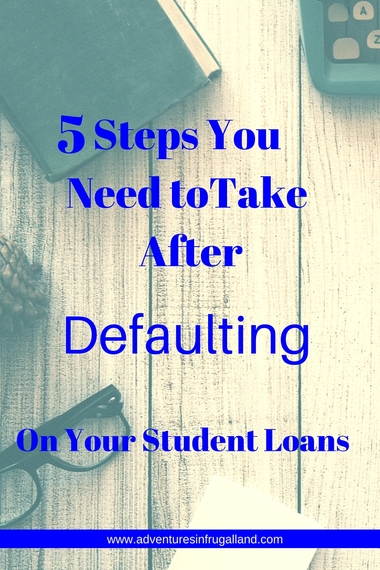Are you in default on your student loans? You are considered in default of your student loans if you fail to make a payment for 270 days. If you are in default, your student loans can be offset, your wages garnished, the amount you owe will increase, your credit score will tank and you will be ineligible to receive any additional financial aid.
Have you defaulted on your student loans? Learn what five steps you need to take.
You do not have to stay in default indefinitely. I've seen several people give up on paying off their student loans once they entered into default. Do not do that! It is possible to get yourself out of default.
Figure Out If You Are Truly In Default On Your Student Loans.
I've heard of people thinking they were in default when they only missed one payment. To be in default, you have to fail to make a payment for 270 straight days. You can check The National Student Loan Data System (NSLDS) for a complete overview of what loans you have. The NSLDS will tell you if any of the loans are in default or not. The NSLDS is not updated daily as the system relays on each individual lender to report any changes.
Contact Your Loan Collection Agency.
This is the most important step and often the hardest. Speaking from experience, it's not a scary process to speak to a loan collection agency after defaulting on your student loans. Inquire if you are eligible for a lower payment or another option. Often, they are willing to work with you. Visit My EDD Debt to determine who your loan collection agency is.
Apply For A Rehabilitation.
If you qualify, you can enter into a rehabilitation agreement with the loan collection agency. A rehabilitation agreement is when you enter into an agreement to pay a set amount each month. This amount could be as low as $5. After making a set number of payments, the loan is out of default. The lenders will also stop reporting the missed payments to the credit bureaus and the negative information will be removed.
Usually, a rehabilitation takes nine months to complete fully. During this time, your loans are still considered in default. This means your federal taxes and wages may still be garnished unless your agreement states otherwise. You can only do a rehabilitation once over the life of the loan.
This arrangement is great for people who are worried about the hit their credit score has taken to defaulted student loans.
Figure Out How Much You Can Afford To Pay Monthly On Your Student Loans.
Make sure you have an accurate idea of how much you can afford to pay each month on your student loans. Be sure to take into consideration your housing expenses, car payments and any other set payments you are responsible for. There are many great options for figuring out budgets.
Decide Between Payment Options.
There are several different payment options. Choose the one that is right for you.
Consolidation
Consolidate your loans into one loan agreement. You can do this online or print and mail the application to the loan providers.
Standard Repayment Plan
The monthly payments are a fixed amount over a set period of time.
Graduated Repayment Plan
Lower payments that slowly increase over time.
Pay As You Earn Repayment Plan (PAYE)
Maximum payments can only amount to 10 percent of your discretionary income.
Income-Based Repayment Plan (IBR)
Maximum payments can only amount to 10-15 percent of your discretionary income.
Income-Contingent Repayment Plan (ICR)
Monthly payments are adjusted to the amount of your income.
Income-Sensitive Repayment Plan
The monthly payment is based on your total income.
Pay your loans in full.
Not many people can afford to do this. If you can, it is certainly the way to go!
**If you choose the Pay As You Earn or the Income Based Repayment Plan, you could have payments as low as $0.00 if your income is low enough.
I've been in default before. As I searched for answers, I found myself even more confused. All I wanted to know was how I can get out of default. While being in default has nasty consequences, it's relatively a simple process to get out of if you follow these five simple steps to take after defaulting on your student loans. While getting out of debt, learn 50 ways to save and make money to be better able to afford your student loan payments.
Have you ever been in default of your student loans? What steps did you take to resolve it?
This post was originally posted on Adventures In Frugal Land.
Connect with me on Facebook.

